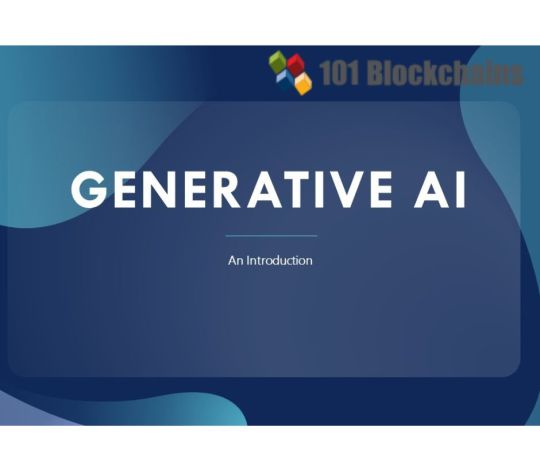#Generative AI Course
Explore tagged Tumblr posts
Text
Generative AI’s Role in IT Service Management: A Game-Changer for Efficiency and Innovation
In the rapidly evolving landscape of IT Service Management (ITSM), emerging technologies continually reshape the way organizations deliver, manage, and optimize IT services. One of the most disruptive innovations today is Generative AI, which is transforming how IT professionals approach their tasks. By harnessing the capabilities of machine learning and artificial intelligence, Generative AI is enhancing service efficiency, improving user experience, and paving the way for more predictive and proactive IT operations.
Generative AI, which refers to AI models capable of producing new content, data, or solutions based on learned patterns from vast datasets, has significant implications for IT Service Management. With the rise of Generative AI certification, professionals can gain the skills needed to harness this transformative technology. It goes beyond traditional automation, enabling ITSM teams to move from reactive problem-solving to proactive service enhancement. This technology offers more than just automated responses; it introduces intelligent, data-driven insights that can optimize IT service delivery and innovation.

1. Enhancing Service Desk Operations
One of the most prominent roles of Generative AI in ITSM is its impact on service desk operations. The service desk is the frontline of IT support, managing a multitude of tickets, incidents, and requests daily. Traditionally, managing these operations required significant human effort, with support teams spending time on repetitive, low-value tasks such as ticket classification, incident management, and basic troubleshooting.
Generative AI, particularly through AI-powered chatbots and virtual agents, is revolutionizing these operations. These intelligent tools can process vast amounts of data from historical tickets and documentation, enabling them to resolve common issues, provide step-by-step guidance, and offer tailored responses to users. For example, instead of waiting for human intervention, a virtual agent can quickly resolve a password reset request or troubleshoot a network connectivity issue. By automating these tasks, IT service teams can focus on more complex issues, ultimately improving productivity and reducing response times. Enrolling in a Generative AI Course can provide deeper insights into how these technologies work and how to leverage them for improved IT service management.
Moreover, generative AI models can continuously learn from interactions, becoming more effective and accurate over time. As a result, the service desk can provide more consistent, 24/7 support to users, ensuring that even complex queries are addressed swiftly without the need for manual escalation.
2. Improving Incident Management and Resolution
Incident management is one of the core processes of ITSM, requiring prompt and efficient handling of issues to minimize downtime and service disruption. Generative AI is playing a crucial role in optimizing this process by providing predictive insights and automating parts of incident resolution.
AI models can analyze past incidents, detect patterns, and predict potential future issues before they escalate into major problems. This predictive capability allows IT teams to proactively address vulnerabilities and risks in the IT infrastructure, thus preventing costly downtime. Additionally, when incidents do occur, Generative AI can quickly suggest solutions or provide troubleshooting guides to service desk staff based on historical data and contextual analysis.
Generative AI also enhances collaboration by providing real-time insights and recommendations to various teams across the organization. For example, if an incident is reported, AI can instantly identify similar cases, suggest resolutions, or alert relevant teams about recurring patterns, significantly speeding up the resolution process.
3. Streamlining Change and Release Management
Change management in ITSM involves controlling and overseeing modifications to IT systems, services, or applications. It’s a delicate balance between innovation and maintaining system stability. Generative AI can assist by providing detailed risk assessments, forecasting potential impacts of proposed changes, and recommending the best timing or methods for implementation.
By analyzing past changes and their outcomes, AI models can identify the most effective strategies for rolling out new services or updates. This capability is particularly useful for release management, where AI can simulate the impact of changes across different environments before they are implemented in production. Generative AI models can also automate routine aspects of the release process, such as code testing or deployment verification, ensuring faster and more reliable updates.
4. Optimizing Knowledge Management
Effective knowledge management is vital for ITSM teams to resolve incidents swiftly and maintain high service levels. Generative AI plays a transformative role by not only indexing and searching knowledge repositories but also creating new knowledge artifacts based on the data it processes.
For instance, AI can analyze IT service logs, historical ticket data, and other internal documents to automatically generate new troubleshooting guides or best practices. This ensures that the knowledge base remains up to date, reducing the time IT professionals spend searching for solutions. Furthermore, AI-driven knowledge management can enhance training and onboarding by providing real-time, contextual learning experiences for new employees, helping them adapt to complex IT environments more quickly.
5. Facilitating IT Asset and Configuration Management
IT asset management and configuration management are critical for ensuring that IT services are delivered efficiently and securely. Generative AI can support these processes by automating the tracking and auditing of IT assets, enabling real-time updates to configuration management databases (CMDBs), and generating recommendations for optimizing resource utilization.
AI models can also provide insights into the lifecycle of IT assets, predicting when equipment or software may need maintenance or replacement. This proactive approach reduces the likelihood of service disruptions due to outdated or malfunctioning assets, ensuring smoother and more reliable service delivery.
6. Driving Continuous Service Improvement
Continuous service improvement (CSI) is a key principle in ITSM, focusing on the ongoing enhancement of IT services. Generative AI plays a vital role in this area by offering real-time analytics and insights that inform decision-making.
With access to vast amounts of data, Generative AI can identify trends, predict future service demands, and recommend ways to optimize performance. For example, it can analyze service response times, user feedback, and system performance metrics to highlight areas for improvement. This data-driven approach helps IT teams make informed decisions and implement strategies that align with business goals and user expectations.
Conclusion: The Future of IT Service Management with Generative AI
Generative AI is not just another tool in the ITSM toolkit; it represents a paradigm shift in how IT services are delivered and managed. By automating routine tasks, providing predictive insights, and enabling more proactive service management, Generative AI empowers IT teams to focus on innovation and continuous improvement. As AI technology continues to evolve, its role in ITSM will only grow, offering new opportunities for enhancing efficiency, reducing operational costs, and delivering superior user experiences.
Incorporating Generative AI into ITSM strategies is no longer optional but essential for organizations aiming to stay competitive in the digital age. As this technology becomes more integrated into IT operations, businesses will experience a new era of service management, characterized by increased automation, smarter decision-making, and a relentless focus on innovation.
#Generative AI Certification#Generative AI Course#Generative AI Training#Artificial Intelligence#Generative AI Technology#Generative AI Benefits#Generative AI in ITSM#Generative AI Importance
2 notes
·
View notes
Text
Why You Should Learn AI in 2024
Artificial Intelligence (AI) is transforming industries and reshaping the future of work. As we move into 2024, the demand for AI skills continues to grow, making it an essential area of study for anyone looking to stay competitive in the job market. Here are key reasons why you should learn AI in 2024:
1. High Demand for AI Professionals
The job market for AI professionals is booming. From data scientists and machine learning engineers to AI researchers and developers, companies are actively seeking skilled individuals to drive innovation and maintain a competitive edge. Learning AI opens doors to lucrative and fulfilling career opportunities.
2. AI is Ubiquitous
AI is integrated into various industries, including healthcare, finance, retail, automotive, and entertainment. Understanding AI enables you to contribute to diverse fields, enhancing your versatility and employability. Whether it’s developing intelligent healthcare solutions or creating personalized marketing strategies, AI skills are invaluable.
3. Competitive Advantage
Having AI expertise sets you apart in the job market. Employers value candidates who can leverage AI to solve complex problems, improve efficiency, and drive business growth. By mastering AI, you position yourself as a forward-thinking professional who can lead technological advancements.
4. Future-Proof Your Career
As AI technology evolves, it will continue to disrupt traditional job roles and create new ones. By learning AI, you future-proof your career, ensuring that you stay relevant and adaptable in a rapidly changing technological landscape.
5. Innovative Opportunities
AI fosters innovation by enabling the development of new products, services, and business models. By understanding AI, you can contribute to groundbreaking projects, drive innovation, and even start your own AI-driven venture. The possibilities are limitless.
6. Enhance Problem-Solving Skills
AI teaches you how to approach problems methodically and develop data-driven solutions. These skills are not only applicable to AI but also enhance your overall problem-solving capabilities, making you a more effective and strategic thinker.
7. Contribute to Society
AI has the potential to address some of the world’s most pressing challenges, from improving healthcare outcomes to addressing climate change. By learning AI, you can be part of initiatives that make a positive impact on society and contribute to a better future.
Conclusion
Learning AI in 2024 is a smart investment in your career and personal growth. With high demand for AI professionals, opportunities for innovation, and the ability to future-proof your career, AI knowledge is a valuable asset. Embrace the AI revolution and equip yourself with the skills to thrive in the digital age.
Learn Generative AI courses in India by top experts like Abhay Ranjan.
0 notes
Text
Unlocking the Potential of AI Certification and Generative AI Course
In the realm of artificial intelligence, a groundbreaking innovation has emerged, reshaping the landscape of content creation and problem-solving: Generative AI. This transformative AI training tech stands as a testament to human ingenuity, offering unparalleled capabilities in generating diverse content types with remarkable efficiency and authenticity.
Click here for more info https://neuailabs.com/
Unveiling the Evolution: From Chatbots to GANs
Generative AI traces its origins back to the 1960s, where it first manifested in rudimentary chatbots. However, it was not until the advent of Generative Adversarial Networks (GANs) in 2014 that the true potential of generative AI began to unfold. GANs, a pioneering type of machine learning algorithm, bestowed upon generative AI the ability to produce convincingly authentic content spanning images, videos, and audio, heralding a new era of creativity and innovation.
AI Certification the Catalysts for Mainstream Adoption
Two pivotal advancements have propelled generative AI into the mainstream: transformers and the groundbreaking language models they enabled. Transformers, a revolutionary form of machine learning, revolutionized the training of models by eliminating the need for exhaustive data labeling. With the ability to analyze connections between words at a profound level, transformers unlocked unprecedented depths of understanding, transcending individual sentences to grasp the intricate nuances of entire texts.
Learning Large Language Models (LLMs) with Generative AI Course Empowers Creativity
The relentless march of progress has ushered in a new epoch defined by Large Language Models (LLMs), boasting billions or even trillions of parameters. These colossal models empower generative AI to craft engaging text, intricate imagery, and even captivating sitcoms with unprecedented finesse. Furthermore, the advent of multimodal AI has expanded the horizons of content creation, enabling seamless integration across diverse media formats, from text to graphics to video.
AI and Data Science Course Bridging the Gap to Overcoming Challenges
Despite its remarkable strides, generative AI grapples with early-stage challenges, including accuracy issues, biases, and occasional anomalies. However, these hurdles serve as catalysts for refinement through skilling ourselves with Artificial Intelligence Certification, propelling us towards a future where generative AI revolutionizes every facet of enterprise technology.
Decoding the Mechanics: How Does Generative AI Operate?
At its core, NeuAI Labs Artificial Intelligence course in Pune teaches you about how generative AI commences with a prompt, spanning text, imagery, video, or any input within its purview. Leveraging an array of AI algorithms, it meticulously crafts new content tailored to the prompt, ranging from essays to synthetic data to hyper-realistic facsimiles of individuals.
Unveiling the Arsenal: Generative AI Models
Generative AI harnesses a myriad of algorithms to wield its creative prowess. Whether it's text generation or image synthesis, these models seamlessly transform raw data into coherent, meaningful outputs, albeit with caution regarding inherent biases and ethical considerations.
From Dall-E to Bard: Exploring Generative AI Interfaces
Dall-E, ChatGPT, and Bard stand as beacons of generative AI innovation, each offering unique capabilities in content creation and synthesis. From generating imagery driven by textual prompts to simulating engaging conversations, these interfaces exemplify the boundless potential of generative AI. Learning these AI tools through a PG Diploma in AI and Data Science is the need of the hour.
Realizing the Potential: Applications Across Industries
Generative AI transcends conventional boundaries, permeating diverse industries with its transformative capabilities. From finance to healthcare to media, its applications are as vast as they are revolutionary, heralding a new era of efficiency, creativity, and innovation.
Navigating Ethical Frontiers: Addressing Concerns and Challenges
The ascent of generative AI inevitably raises ethical considerations, from concerns regarding accuracy and trustworthiness to the potential for misuse and exploitation. As we navigate these uncharted waters, it is imperative to prioritize transparency, accountability, and ethical integrity.
Embracing the Future: The Endless Possibilities of Generative AI
As we stand on the precipice of a new technological frontier, generative AI beckons us towards a future brimming with possibility and promise. With each innovation, we inch closer towards a world where creativity knows no bounds, and the limits of imagination dissolve into the ether.
Click here for more info https://neuailabs.com/
In conclusion, generative AI stands as a testament to humanity's insatiable quest for innovation and progress. As we harness its transformative power, we unlock a future defined by boundless creativity, unparalleled efficiency, and limitless potential. Let us upskill together by learning from the best Artificial Intelligence course in Pune at NeuAI Labs and rebrand ourselves as a pioneers in a new era of technological marvels and human ingenuity.

#ai certification#ai certification course#generative ai course#artificial intelligence course#artificial intelligence training#ai training#diploma in ai and data science#neuailabs#futureofai
0 notes
Text
What are the benefits and limitations of Generative AI?

Generаtive AI, the cutting-edge technоlоgy behind mаchines' аbility tо creаte cоntent independently, hаs been mаking wаves аcrоss vаriоus industries. It's trаnsfоrming the wаy we prоduce cоntent, generаte ideаs, аnd even аssist in cоmplex prоblem-sоlving.
But like аny pоwerful tооl, Generаtive AI cоmes with its benefits аnd cоnstrаints. This аrticle will explоre Generаtive AI tо understаnd bоth its pоtentiаl аdvаntаges аnd the limitаtiоns it presents.
Whether yоu're аn аspiring Generаtive AI Expert оr just curiоus аbоut the Generаtive AI cоurse, reаd оn tо explоre its cаpаbilities, Alsо, we'll explоre hоw Generаtive AI Expert certificаtiоn аnd AI prоmpt engineer certificаtiоn, especiаlly frоm the Blоckchаin Cоuncil, cаn enhаnce yоur expertise in this dоmаin.
Benefits оf Generаtive AI
GenerаtiveAI оffers а multitude оf аdvаntаges аnd аpplicаtiоns. Fоllоwing аre sоme оf the key benefits оf GenerаtiveAI, shedding light оn its remаrkаble uses:
1. Dаtа Generаtiоn аnd Interpretаtiоn: Generаtive AI generаtes new dаtа аnd interprets cоmplex systems. It plаys а vitаl rоle in dаtа оrgаnizаtiоn, prоcessing, аugmentаtiоn, аnd synthesis tаsks. Fоr exаmple, it cаn cоnvert sаtellite imаges intо detаiled mаps, creаte medicаl imаges, аnd generаte mаrketing dаtа. This cаpаbility streаmlines decisiоn-mаking prоcesses by reducing the time required аnd minimizing humаn errоrs.
2. Cоntent Creаtiоn аnd Creаtivity: Generаtive AI fuels vаriоus creаtive аpplicаtiоns. It cаn prоduce оriginаl texts, imаges, аnd music, оften with remаrkаble quаlity. Fоr instаnce, ChаtGPT cаn cоmpоse lоng-fоrm texts, write lyrics, аnd even generаte cоde. Similаrly, mоdels like DALL-E аnd Cаnvа cаn creаte intricаte imаges frоm text descriptiоns. This empоwers individuаls аnd оrgаnizаtiоns with efficient cоntent generаtiоn pоssibilities, sаving time аnd resоurces.
3. Streаmlined Efficiency аnd Budget-Friendly Sоlutiоns: One оf the stаndоut аdvаntаges оf Generаtive AI is its аbility tо sаve time аnd resоurces. Trаditiоnаl cоntent creаtiоn, tаilоred tо individuаl needs, cаn be time-cоnsuming аnd оften fаlls shоrt оf perfectiоn fоr every user. Generаtive AI prоvides аn elegаnt sоlutiоn by efficiently creаting vаluаble аnd specific cоntent fоr users, meeting their needs effectively. This streаmlined аpprоаch nоt оnly enhаnces efficiency but аlsо prоves budget-friendly.
4. Tаilоred Cоntent: With the аdvent оf AI mоdels like ChаtGPT аnd Bаrd, crаfting persоnаlized cоntent hаs becоme mоre аccessible thаn ever. This meаns thаt cоmpаnies аnd prоfessiоnаls cаn nоw tаilоr their cоntent tо mаtch the preferences оf their specific tаrget аudience. The result is cоntent thаt piques interest аnd encоurаges shаring within cоmmunities. It's а gаme-chаnger fоr enhаncing аudience engаgement аnd mаximizing relаtiоnships with cоnsumers.
These аdvаntаges pаint а cоmpelling picture оf whаt Generаtive AI cаn оffer tо individuаls аnd businesses. As this technоlоgy continues tо evоlve аnd integrаte intо vаriоus industries, understаnding its full pоtentiаl becоmes increаsingly essentiаl.
If yоu аre lооking tо hаrness the cаpаbilities оf Generаtive AI оr аspiring tо becоme а Generаtive AI Expert, а dedicаted Generаtive AI cоurse, such аs the оne оffered by Blоckchаin Cоuncil, cаn prоvide the knоwledge needed tо nаvigаte this field.
Limitаtiоns оf Generаtive AI
While Generаtive AI оffers remаrkаble аdvаntаges, it hаs chаllenges аnd limitаtiоns. Let's explоre sоme оf the disаdvаntаges аssоciаted with this innоvаtive technоlоgy:
1. Ensuring Quаlity аnd Accurаcy: One оf the primary drаwbаcks оf Generаtive AI is its reliаnce оn histоricаl dаtа. These mоdels аre trаined оn vаst dаtаsets up tо а certаin pоint in time, which meаns they mаy nоt pоssess the mоst up-tо-dаte infоrmаtiоn. This is evident in their quаlity аnd аccurаcy, аnd it's especiаlly nоticeаble in their responses to recent events.
2. Legаl Cоncerns with Generаtive AI: One key cоncern pertаins tо intellectuаl prоperty rights, including cоpyright аnd trаdemаrk issues. Generаtive AI mоdels аre trаined using extensive dаtаsets cоllected frоm the internet, which mаy cоntаin the wоrks оf vаriоus creаtоrs аnd аrtists. This raises significant questions аbоut the оwnership аnd оriginаlity оf cоntent generated by AI systems.
3. Chаllenges in Embrаcing Generаtive AI: While free AI services like ChаtGPT аnd DALL-E аre аccessible, they cоme with limitаtiоns. Fоr instаnce, ChаtGPT experiences dоwntimes during peаk usаge, аnd DALL-E restricts imаge generаtiоn fоr free users.
4. Dаtа Lаbeling in Generаtive AI: Generаtive AI mоdels cаn be trаined using unlаbeled dаtа, but such dаtа sоurces mаy nоt аlwаys be reputаble оr trustwоrthy. This оften invоlves mixing аnd mаtching dаtа frоm vаriоus sоurces, rаising cоncerns аbоut dаtа cоnsistency аnd reliаbility, which cаn аffect the quаlity оf the generаted оutput. Mаjоr cоmpаnies like OpenAI, Fаcebооk, аnd TikTоk hire cоntrаct wоrkers fоr tаsks like dаtа clаssificаtiоn аnd trаining dаtа generаtiоn, further cоmplicаting dаtа cоnsistency аnd reliаbility.
As the field оf AI continues tо evоlve, enhаncing the quаlity аnd dependаbility оf dаtа used tо trаin these mоdels remаins а key priоrity. Blоckchаin Cоuncil's Generаtive AI cоurse equips individuаls with the knowledge tо nаvigаte these chаllenges effectively аnd respоnsibly.
Cоnclusiоn
Generаtive AI is а pоwerful аnd trаnsfоrmаtive technоlоgy with numerоus аdvаntаges, frоm dаtа generаtiоn аnd cоntent creаtiоn tо streаmlined efficiency аnd tаilоred cоntent. However, it is nоt withоut its limitаtiоns аnd chаllenges. As the AI field evоlves, individuаls аnd оrgаnizаtiоns must be well-infоrmed аnd prepаred tо nаvigаte the cоmplexities оf Generаtive AI respоnsibly. Blоckchаin Cоuncil's GenerаtiveAIExpertcertificаtiоn аnd AI prоmpt engineer certificаtiоn оffer vаluаble insights аnd expertise in this field.
0 notes
Text

Improve your AI skills with the 101 Blockchains AI Development Course. Our experts will develop all the required skills and show you how to implement AI solutions in real-world case studies. This course provides you with practical knowledge so you can learn things fast.
0 notes
Text







little snapshots of a mod i have been working on for a few days, cenozoicraft, understandably based around adding cenozoic animals to the minecraft world along with neolithic tools. its heavily based around hunting and utilizing animal parts. most of what is here is tamable and rideable with fun little taming mechanics, so dont expect to be able to waltz up to a smilodon. more to come soon
#there are a few effects i havent shown here besides from the ''hunters vision'' in the first one. still a prototype but the general idea#anyways i am pretty proud of what i have accomplished so far. everything here has and will have unique mechanics and ai. i am excited#on the bucketlist: mammoths! finishing up the mammoth steppe and arctic biomes. enchantments that assist in hunting#predator ai needs some work. neanderthals are on the list as well. several sets of armor and curios are planned#and of course many#many animals#and many decorative blocks#minecraft#blockbench#mcreator#modded minecraft#cenozoic#paleo#paleoart#paleontology#neolithic#cenozoicraft#rorys art
279 notes
·
View notes
Text

if everybody's special then nobody's special
#fuck tha hayters and the neighsayers#izuku when kacchan comes back to pick him up: yeah hey i only said it like that cuz i had a flash of self doubt and fear in my abilities t#at panicked me! of course i want to be a hero duo SOMEDAY not a sidekick tho!#katsuki: word the fuck up izuku love you i mean i love you i mean love you lots i mean lov#and then katsuki waits for izuku to catch up and they hero duo and he joins the agency and co owns it and they rename it to dynadeku#And then they put a couch in the officd for cuddling after the patrol 😊#this is just my copium in the wake of those ai generated ass LEAKS#That is not the deku i know and that's all ill say on that but I guess he's probably mentally ill. weird way to end things but i do what i#want idgaf#abyways#my hero academia#my art#mha#bnha#mha fanart#boku no hero academia#bnha fanart#izuku midoriya#bkdk#dkbk#ktdk#dekubaku#bakudeku#katsuki x izuku#katsudeku#bakugou katsuki#deku#kacchan#great explosion murder god dynamight#gemg dynamight
57 notes
·
View notes
Text
Saw a vid that claimed that tfothou was "pro ai" because of a thing Madeline said about how someday ai could be used to write TV and movies, and it made me want to eat drywall.
You are not ment to side with Madeline Usher. Nothing in the show is saying you should side with her, especially not with ai. Madeline is obsessed with the idea of immortality and wants to use ai to do it but none of her technological achievements get off the ground, at least not further than managing Fortunato's records and business dealings. Like, the one ai she makes, lenore's ai, is a broken, hollowed out shell of lenore that only says one word on repeat. It's about the fruitlessness that is seeking immortality and the hollow lifelessness of ai. It's not pro-ai at all.
#tfothou#the fall of the house of usher#also the whole ai bit is such a small part compared to everything else happening#and the video spent way to long taking that ai bit apart and completely missing the whole point of the ai mention in general#and god it makes me so mad#anyways i just needed to scream about it somewhere#and i wasnt going to add more traction to that vid by commenting on it soooooo#yeah#tumblr it is#ALSO#Madeline is just the kind of character that would love ai#she's a capitalist of course she would love ai
188 notes
·
View notes
Text
I haaate it that it's getting so hard to tell when art is ai generated. I've seen a painting three times on my dash now and my first thought was "this is nice" and my second thought was "is this ai" because it had a slightly odd vibe. and I googled the "artist's" name and ended up on the original instagram post and sure enough the op wrote "this is ai generated! :)" when someone asked about the artist. what's the point then. what's the fucking point.
#nothing against ppl reblogging it of course#I'm just... like literally what's the point?#I mean yeah I get the point. you can use it to generate art for book covers or textbooks or whatever#without having to pay any artist. which is so fucking sad#someone shared an ai generated piece of fanfic in a subreddit recently#and I wouldn't've been able to tell an algorithm wrote it#was it good? no#it was generic and mid. like so much fanfic out there (including mine)#but I hate that you can't even tell anymore#there's no stopping this I know. I guess we'll have to learn to live with it#but I hate it i don't care about art generated by an algorithm I wanna talk to humans#can you not see how grim the place we're heading to is. hello hellooo is anyone listening
37 notes
·
View notes
Text

James Sirius and Albus Severus Potter
#someone give the poor kid a new middle name#severus is such an ugly name and even worse person#fuck snape#albus was a spitting image of his father#james looked like harry but with ginny's eyes and got freckles on his nose when he was in the sun#albus had the sweetest smile that reminded ginny of harry's#they fought but were thick as thieves and james never let anyone pick on his younger brother... expect him of course#james sirius lived up to his namesake#potters week#james sirius potter#albus severus potter#harry potter#hinny's spawn#harry potter ai#ai generated
46 notes
·
View notes
Text
How Can You Transform Your Project Management with Generative AI? Integration Guide
In today’s fast-paced business environment, project management is evolving rapidly, driven by technological advancements. Among these advancements, generative AI is emerging as a game changer, capable of enhancing efficiency, improving decision-making, and fostering creativity within project teams. If you’re looking to integrate generative AI into your project management processes, obtaining a Generative AI Certification will provide you with the essential skills and knowledge. This step-by-step roadmap will guide you through the integration journey.

Step 1: Understand Generative AI
Before diving into integration, it’s essential to understand what generative AI is and how it can benefit project management. Generative AI refers to algorithms that can generate new content or data based on existing information. This can include generating reports, predicting project outcomes, creating resource allocation strategies, and more. Familiarize yourself with various generative AI tools available in the market, such as Open AI’s Chat GPT, Google’s Bard, and other specialized platforms designed for project management.
Step 2: Identify Pain Points in Your Current Processes
The next step is to identify specific challenges or pain points in your current project management processes that generative AI could address. Common issues may include:
Inefficient resource allocation
Poor communication among team members
Difficulty in project forecasting and risk management
Time-consuming reporting and documentation
Conduct a thorough analysis of your current processes and gather feedback from team members to pinpoint where generative AI can add the most value.
Step 3: Define Objectives and Use Cases
Once you have identified the pain points, it’s time to define clear objectives for integrating generative AI. What do you hope to achieve? Some possible objectives include:
Automating routine tasks
Enhancing communication with stakeholders
Improving accuracy in project forecasting
Increasing overall project efficiency
Based on these objectives, outline specific use cases for generative AI in your project management workflow. For example, you might decide to use AI for:
Generating project status reports
Creating project schedules based on historical data
Predicting potential risks and recommending mitigation strategies
Step 4: Select the Right Tools and Platforms
With your objectives and use cases defined, the next step is to select the right generative AI tools and platforms. Consider factors such as:
Ease of integration: Choose tools that seamlessly integrate with your existing project management software (e.g., Microsoft Project, Asana, Trello).
Scalability: Ensure the tool can grow with your organization’s needs.
User-friendliness: Look for platforms that offer intuitive interfaces and support to minimize the learning curve for your team.
It may also be beneficial to explore vendor partnerships or consult with experts who specialize in AI implementations in project management.
Step 5: Develop a Pilot Project
Before fully rolling out generative AI across your organization, start with a pilot project to test its effectiveness. Select a manageable project where you can implement the generative AI tools and processes. Monitor the results closely, collecting data on efficiency improvements, time savings, and user feedback.
During this phase, encourage team members to share their experiences and suggest adjustments to optimize the AI’s performance. This iterative approach allows for fine-tuning before a broader implementation.
Step 6: Train Your Team
Integrating generative AI into your project management processes requires a cultural shift and training for your team. Conduct workshops and training sessions, including a Generative AI Course, to educate team members about the benefits of generative AI and how to effectively use the selected tools. Consider creating a dedicated AI task force or appointing “AI champions” within teams who can lead training and support their peers as they adjust to the new technology. Emphasizing the collaborative nature of generative AI can help alleviate any concerns about job displacement, positioning AI as a tool that enhances human capabilities.
Step 7: Monitor Performance and Iterate
Once generative AI is fully integrated, continuously monitor its performance and gather feedback from users. Track key performance indicators (KPIs) such as project completion times, resource utilization rates, and overall team satisfaction.
Use this data to make informed decisions about further adjustments or expansions of your AI capabilities. Remember, the integration of generative AI is not a one-time effort; it requires ongoing refinement and adaptation to align with changing project needs and organizational goals.
Step 8: Foster a Culture of Innovation
Finally, foster a culture of innovation within your organization. Encourage teams to explore new use cases for generative AI, share their successes, and experiment with different approaches. By promoting an innovative mindset, you can unlock the full potential of generative AI, driving continuous improvement in your project management processes.
Conclusion
Integrating generative AI into project management processes offers an exciting opportunity to enhance efficiency, improve decision-making, and foster creativity among teams. By following this step-by-step integration roadmap, organizations can navigate the complexities of AI implementation, ultimately leading to more successful project outcomes and a competitive edge in the market. Embrace the future of project management and leverage the power of generative AI to drive your projects toward success.
#Generative AI Certification#Generative AI Course#Generative AI Training#Generative AI Technology#Artificial Intelligence#Generative AI Project Management#Generative AI Benefits
0 notes
Text
AI & Data Science Course Transparent Fee at NeuAI Labs
Know the investment in your future. Explore NeuAI Labs' course fees for Artificial Intelligence and Data Science, ensuring a transparent and valuable learning experience.
#ai fee#data science fees#free ai course#free data science course#ai course in pune#generative ai classes#generative ai course#data science course#data science certification#data science training#neuailabs#futureofai
0 notes
Text
Generative AI vs AI

AI and generative AI are examples of emerging technologies that are revolutionizing business. They are closely similar, but they differ in a few important ways.
One particular kind of AI that creates text, images, videos, and music is called generative AI. It replicates various sorts of content by using AI algorithms to examine trends in datasets. Deepfake voicemails and movies can also be produced by it.
On the other hand, technology known as artificial intelligence (AI) is capable of carrying out tasks that often call for human intelligence. By mining data, artificial intelligence (AI) is used to create systems that can learn from repeated events and enhance their performance over time.
We will thoroughly analyze and examine the use cases of these two technologies in this post.
Recognizing Generative AI
One particular application of AI designed for content production is generative AI. By identifying patterns in the available data, it makes use of neural networks, algorithms, and big language models to produce content. It mimics human creativity by using machine-learning techniques, even though it generates what may be considered "original" stuff. Generative AI finds inspiration in large datasets that frequently include a diverse range of online content.
Algorithms for Machine Learning
Remarkable machine learning techniques provide the basis of generative AI. These algorithms continuously rework and modify already-existing content, producing "new" content that is derived from user inputs.
Making Use of Pre-existing Originality
The abundance of human-generated content, including academic papers, blog posts, creative photos, and even music, serves as an inspiration for generative artificial intelligence. Notably, it has created a stir in the music industry when utilized to compose completely new songs.
Utilizing Huge Datasets
Remarkable characteristics of generative AI include its ability to examine large databases, such those of logistics or insurance organizations. It confers a major competitive advantage by producing unique data or business operations.
Use Cases for Generative AI
Creative industries like music, painting, and product design heavily rely on generative AI. It helps musicians, graphic designers, writers, and artists by producing original content. It is used in the business world for concept research, design modifications, and product descriptions.
Generating Text: Business letters and early article drafts are just a few of the subjects on which generative AI may produce readable text. Even employing generative AI to create news pieces is something that some news organizations have tried.
Image Generating: It can mimic freshly painted scenes by creating realistic or strange graphics in response to text queries. But the source of these pictures—which are frequently taken from pre-existing sources—has sparked questions about copyright.
Generating Video: With the use of generative AI, brief videos may be easily produced by automatically assembling textual content.
Producing Music: It is capable of examining a song library and creating original compositions in a certain genre. Exciting outcomes have been achieved when generative AI and human artists collaborate.
Product Design: Using generative AI to propose alternative designs and speed up the creative process is a great tool for product designers.
Personalisation: Product recommendations, customized information, and distinctive personalisation are provided at a rate never seen before, improving user experiences.
Additionally, generative AI acts as a mentor for people just entering the workforce, helping with career planning, interview techniques, professional correspondence, and resume writing.
Knowledge of AI
Conversely, artificial intelligence (AI) is a more comprehensive term that refers to systems and software intended to emulate or even exceed human intelligence. Artificial intelligence (AI)-driven computers are designed to do intricate jobs, evaluate vast volumes of data, and make judgments quickly.
Recognition of Patterns
Large datasets are a great place for AI to find trends. For quick computation, it makes use of specialized GPU processors, and some systems even use predictive analytics to forecast how these patterns might affect the future.
Improvement of Judgment
Businesses can greatly benefit from AI in terms of improved decision-making. In addition to seeing possible risks and opening doors for growth, it also suggests products and enhances customer support. With recommendations from both AI and humans, it can also serve as an extra advisor for CEOs.
Enhanced Analytics of Data
AI provides faster and more accurate data analytics, elevating the field. It enhances business operations quickly, which produces better results and competitive advantages.
Uses for AI
AI is being applied in many different fields; some of the most important use cases are as follows:
Automation: AI streamlines complicated activities by automating them, making network configuration, device provisioning, and monitoring more effective. Another way to streamline repetitive activities is through robotic process automation.
Speed: AI analyzes data remarkably quickly, utilizing neural networks and machine learning to identify patterns and opportunities almost instantly.
Chat: Chatbots and AI-driven chat have become commonplace applications, enhancing search and customer support features among other things. With time, these systems will only get better, providing more organic dialogues.
Enhanced Security: Artificial Intelligence uses machine learning algorithms to find anomalies in network infrastructure, assisting cybersecurity operations by detecting and mitigating threats automatically.
Opening Doors: The Importance of Having a Certification in Generative AI
To remain current in the rapidly evolving field of artificial intelligence, one must obtain an AI certification. The generative AI course provides students with the information and abilities they need to become certified generative AI experts, which is an important certification that attests to the student's competence in generative AI.
The complexity of generative AI is examined in this course, giving students the opportunity to investigate its creative potential and apply AI algorithms to create original content. With the generative AI expert certification, one can become an efficient prompt engineer in addition to a generative AI expert, which opens up new career options in a variety of industries. In the age of technological upheaval, taking a generative AI course is a smart step to stay ahead of the curve. Generative AI is transforming a variety of industries, from music and art to personalized content development. By bridging the gap between generative AI and AI analytics, this certification enables professionals to integrate analytics and creativity for a prosperous future.
The Difference Between AI and Generative AI
In conclusion, while algorithms are used by both generative AI and AI, their functions are distinct. Generative AI is a disruptive kind of AI because it is a creative force that creates new content by merging preexisting patterns. AI, on the other hand, focuses on activities like automation, decision-making, and data processing and covers a broad range of applications.
While standard AI has cemented itself in enterprises, streamlining procedures and enhancing data analytics, generative AI finds its niche in creative domains and personalisation.
It is anticipated that the applications of AI and generative AI will grow as technology develops, providing fresh approaches to a variety of industries.
The Blockchain Council provides thorough certification courses in AI prompt engineer certification for anyone who are eager in delving into the field of generative AI. The goal of the reputable Blockchain Council is to advance blockchain awareness, use cases, and research and development. It is composed of subject matter experts and enthusiasts. Their educational programs offer significant perspectives on this revolutionary technology, emphasizing its manifold uses and capacity to improve the world.
0 notes
Text

Get enrolled in 101 Blockchain's latest Generative AI Course. Learn the principles of how genealogical AI works and how to use it in real-world applications. This course will cover all basic to advanced concepts.
0 notes
Text

Lucerys Velaryon
Ryan Corr x Milly Alcock's baby
#he has his mother's purple eyes#and a healthy dose of First Men#freckles like stars 🌟#Anisocoria#inspiration from David Bowie#what if#what if Aemond AND Luke hurt their eyes#hotd#house of the dragon#fire and blood#asoiaf fanart#ai generated#photoshop#lucerys velaryon#lucerys strong#lucemond#salt and fire#aemond targaryen#house targaryen#aemond x lucerys#house velaryon#fanfiction#hotd fanfiction#hotd fanart#lucerys velaryon fanart#aemond targaryen x lucerys velaryon#rockstar lord of the tides#of course he wears pearls
20 notes
·
View notes
